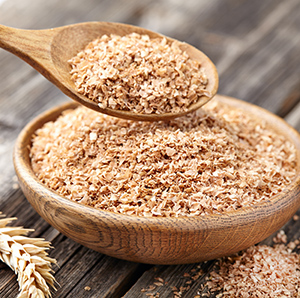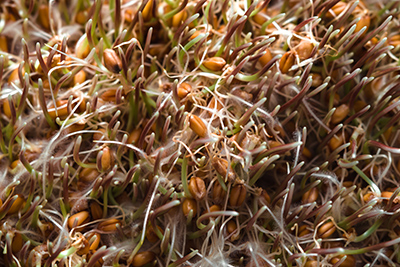Contents
Wheat germ vs wheat bran: What’s the Difference? Before we can learn the difference, we have to look at the anatomy of a grain of wheat. The wheat grain is the “whole egg” because its three parts (endosperm, germ, and bran) form a balanced nutritional unit. Humans have changed this wise natural balance by making flour from only the endosperm and separating the bran and germ.
This seemingly unimportant fact has contributed to the increase in cancer, intestinal diverticulosis, hemorrhoids, heart attacks, degenerative diseases, and arteriosclerosis in the last century. Because of this, someone once said, “What God has joined, let no man tear asunder.”
Bran or Pericarp – This is the outer layer of the grain after removing the straw or shell. It is formed of six layers, all rich in cellulose fiber.
Endosperm or Nucleus – The endosperm of a grain of wheat, the source of white flour, is formed of an internal cellulose membrane surrounding starch granules and gluten particles. The white flour from the endosperm contains many proteins (gluten), although they are incomplete. Their quality increases when they are combined with lysine-rich proteins such as those contained in:
- Wheat germ, just as it occurs naturally in whole-grain products
- Milk and dairy products
- Legumes
Germ – This is the grain embryo from which a new wheat plant will sprout. It contains all the substances necessary to produce a complete plant, which explains its extraordinary nutritional richness. The germ contains three-fourths of all vitamins B and E in the grain.

Wheat Germ vs Wheat Bran
Wheat bran’s action can be compared to a sponge or broom acting on the intestine’s interior.
Composition – Wheat bran contains abundant proteins, fats, vitamins, and minerals, although humans poorly utilize these since they are encapsulated in undigestible cellulose fiber. However, interest in bran has less to do with what it provides than with its fiber richness, which reaches forty-three percent. Bran fiber consists of hemicellulose, cellulose, and lignin (responsible for its rugged, woody consistency).
Physiological Activity – Bran produces three primary effects in the intestine:
- It retains water, increasing the volume and weight of the feces. Each gram of bran increases fecal weight by 2-3 grams.
- It increases the speed of fecal movement through the intestine.
- It adsorbs—in other words, retains and eliminates through the feces—irritants, toxic substances, cholesterol, biliary salts, and carcinogens in the intestine.
Benefits of Bran
- It compensates for the lack of fiber in the diets based on refined foods, although eating whole grains is preferable to eating refined grains and adding bran to compensate.
- It prevents constipation. 20 to 30 grams daily for at least a week is necessary to achieve the desired effect.
- It reduces cholesterol levels, although oat bran is much more effective.
- It reduces the risk of diverticulitis, colon cancer, coronary disease, and breast cancer.

Drawbacks to Bran
Intestinal irritation—Bran can irritate the intestinal mucosa because of the toughness of the lignin it contains. Its use is discouraged in cases of colitis and irritable bowel syndrome.
Its phytate content – Phytates are the salts of phytic acid (inositol hexaphosphate) found in grain bran (200 to 800 mg/grams), nuts, and legumes. They are very active substances whose effects are both positive and negative:
Adverse effects of phytates – These form insoluble compounds of iron, zinc, and calcium, which impede the absorption of these minerals in the intestine. The diminution of bioavailability of minerals due to bran phytates is less significant than what was formerly believable due to the following reasons:
- Soaking, heat, fermentation, and sprouting activate an enzyme called phytase, also found in bran from grains. This enzyme hydrolyzes phytates, destroying them so that phytates disappear almost entirely in whole grains.
- Vitamin C fosters iron absorption from grains and compensates for the inhibiting effect that phytates may exert.
Positive effects of phytates—Recent research shows that phytates are not as harmful as some nutritionists think. What used to be considered an anti-nutritive factor is now a health protector. For an unknown reason, phytates must be present in grains and seeds.
Antioxidant—When phytates combine with iron, which behaves like a free radical with intense oxidizing action, they prevent an excess of this mineral from harming the intestinal lining and becoming a factor in cancerous degeneration.
Anticarcinogenic—Several studies show that phytates and phytic acid are anticarcinogens, both in vivo and in vitro. This partially explains the cancer-preventive action that whole grains possess.
Summing Up
When cooked, sprouted, or fermented whole grains (bread, pastries) are consumed, phytates have no adverse effects on iron, zinc, or calcium absorption.
When bran is consumed independently, without being part of the grain, phytates may persist that have not been rendered inactive by phytase. They may reduce mineral absorption. That is why surpassing 30 grams of bran a day is not advisable.
Pollution – Bran is in contact with the outside and can be contaminated by:
- Pesticides.
- Heavy metals: Bran contains 7 to 50 times more lead and 3 to 9 times more cadmium than flour.
- Aflatoxin-producing molds. Washing or friction and vacuuming grains, before they are ground, eliminate most molds from the bran.
How to use Bran Correctly
Consuming bran in its natural state, with the rest of the kernel, is preferable as a part of whole-grain wheat or its derivatives.
If bran is eaten independently, we insist that 30 grams (about one ounce) a day is not exceeded. If possible, it should come from biological plantations.
Consuming bread and whole grains in which bran is present is better than eating bran alone. In this case, 30 grams (two spoonfuls, about one ounce) a day should not be exceeded.
What is Wheat Germ?

What is wheat germ? Wheat germ is the segment of the grain richest in nutrients and active substances, particularly:
Proteins (23.2 percent) from the gluten from the endosperm are more complete than those from the gluten because they are not lysine-deficient.
Essential fatty acids (9.72 percent) include linoleic acid and alpha-linolenic acid (omega-3).
Vitamins B1, B2, B6, niacin, and folates.
Vitamin E is a powerful antioxidant.
Minerals, particularly phosphorous, magnesium, iron, and trace elements.
Enzymes such as the antioxidant superoxide-dismutase.
Octacosanol – This substance is found in wheat germ and its oil and lower proportions in other seed oils. Its chemical formula is C28h58O. It has been shown to improve fatigue resistance and performance in athletes naturally.
Every hundred grams of wheat germ (approximately ten spoonfuls) covers the RDA (Recommended Daily Allowance) of vitamin B1, folates, vitamin E, phosphorous, and manganese. The standard dose is from two to four spoonfuls with breakfast. Its use is especially recommended in the following cases:
Nervous system disorders require extra B vitamins: asthenia (fatigue), depression, stress, nervousness, etc.
Male and female sterility from gonadal causes since vitamin E promotes sperm production and ovulation.
Hyperlipidemia (increased fats in the blood0, particularly types IIa and IIb. A study by INSERM (the French National Institute for Health and Medical Research in Marseille) shows that 20 to 30 mg of wheat germ daily for four months reduces LDL cholesterol (harmful) by fifteen percent and triglycerides by eleven percent.
Cancer, cardiac disease (heart attack and angina): Because of its antioxidant effect, it halts degenerative cellular processes, aging, and arteriosclerosis.
Diabetes: Doctor Schneider describes Professor Stepp’s studies, in which consumption of four or five spoonfuls of wheat germ a day lowers diabetics’ glucose levels, even to the point of reducing insulin need. This anti-diabetic effect is attributed to the combined action of vitamins B1 and E, abundant in wheat germ.
Whenever there is an increased need for nutrition: Athletes, students under particular intellectual stress, pregnant or lactating women.
DISCLAIMER: All content on this website is presented solely for educational and informational objectives. Do not rely on the information provided as a replacement for advice, diagnosis, or treatment from a qualified medical expert. If you are pregnant, nursing, or have any preexisting medical concerns, talk to your doctor before using any herbal or natural medicines.
REFERENCES
- George D. Pamplona-Roger, M.D. “Encyclopedia of Foods and Their Healing Power.” George D. Pamplona-Roger, M.D. Encyclopedia of Foods and Their Healing Power. Trans. Annette Melgosa. Vol. 2. Chai Wan: Editorial Safeliz, 2005. 310, 311. Print. [wheat germ vs wheat bran]
- Wheat bran: https://fdc.nal.usda.gov/fdc-app.html#/food-details/170418/nutrients
- Wheat germ: https://fdc.nal.usda.gov/fdc-app.html#/food-details/170285/nutrients
- https://www.mayoclinic.org/healthy-lifestyle/nutrition-and-healthy-eating/in-depth/fiber/art-20043983
- https://pubchem.ncbi.nlm.nih.gov/compound/Phytic-acid
